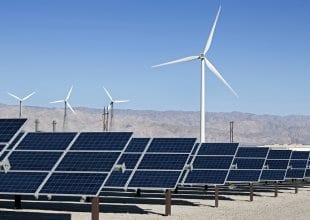Despite all the Coalition government rhetoric about its support for renewable energy and its proposed “doubling” of installations over the next 5 years, Australia has emerged as one of the principal black spots in the latest global report on renewable energy.
The Medium Term Renewables Market Report released overnight by the International Energy Agency highlights the impact of the dramatic cut in the 2020 renewable energy target imposed by the then Abbott government, and supported by Labor.
It also warns that the most prospective part of Australia’s renewasble energy growth – the domestic solar PV market – could be impacted as utilities and regulators impose changes in tariffs that allow networks to recoup fixed costs.
The findings were to be presented today (Friday) at the G20 energy ministers meeting, which newly appointed Australian energy minister Josh Frydenberg was attending.
Frydenberg has been telling journalists from Istanbul that Australia’s “bipartisan” target of 33,000GWh has been applauded by the G20 meeting.
But the G20 report tells us a different story. It notes that this new target is a cut from the previous bipartisan target of 41,000GWh, and will mean that it has had to cut its own forecast for new renewable energy generation to 11,000GWh from 19,000GWh.
Australia may double renewable energy by 2020, but its previous policy would have encouraged a near trebling of capacity.
“Australia’s renewable electricity forecast is less optimistic” than last year’s report, the IEA noted. It expects wind capacity to grow to 6.8GW from 3.8GW, while solar capacity will jump to 9GW from 4.1GW.
Much of this will come from rooftop solar, which the IEA noted is at “socket parity” in most Australian cities. That means that rooftop solar is cheaper than the variable cost of power from the grid.
But it warns that this outlook could be clouded by changing tariffs. “The economic attractiveness of deployment over time will depend on the evolution of retail electricity tariffs and FiT levels to remunerate excess electricity exported to the grid (important for households whose demand profile during the day may be lower than the output from the solar PV system),” it says.
“Debates in several Australian states over electricity rate design and the recovery of fixed network costs amid a situation of falling demand and rising self-consumption from solar PV cast a degree of uncertainty over the forecast.”
The declining outlook in Australian renewables is a key point for the IEA, which says that renewable energy is gaining traction throughout the world, and needing less subsidies, but is still dependent on solid government policy.
 The IEA, one of the world’s most conservative institutions, predicts that renewable energy will account for nearly two thirds of new global capacity in the next five years, and will play a key role in convincing countries that ambitious emissions reductions can be affordable.
The IEA, one of the world’s most conservative institutions, predicts that renewable energy will account for nearly two thirds of new global capacity in the next five years, and will play a key role in convincing countries that ambitious emissions reductions can be affordable.
The IEA says rapid cost falls in both wind and solar means that renewable energy generation will account for 26 per cent of all generation by 2020 – more than today’s total combined demand of China, India and Brazil.
As renewable energy naysayers, led by the likes of climate contrarion Bjorn Lomborg continue to downplay the impact of renewable energy, it is becoming increasingly obvious to others that renewables are having a real impact.
The National Renewable Energy Laboratory in the US this week noted that utility-scale solar is now being built in the US at around 5c/kWh, putting it on par on costs with gas, even the relatively “cheap” shale gas in the US.
The IEA, an organisation set up in the 1970s to protect developed countries’ access to fossil fuels, particularly oil, hasn’t yet caught up with real-world pricing, but it too says that wind and solar is becoming increasingly competitive with fossil fuels.
It predicts that 700GW of renewable energy will be installed across the globe over the next five years. This actually suggests a slowing down of current installations, and is contrary to most private forecasts.
IEA executive director Fatih Birol says that while renewable energy sources will need fewer subsidies, they will require steady policy.
“Governments must remove the question marks over renewables if these technologies are to achieve their full potential,” said.
The report said that “wavering policy commitment to decarbonisation and diversification in response to such efforts can undermine investor confidence, and retroactive changes can destroy it.”
The IEA report noted that solar and wind had both experienced rapid cost falls in recent years – 60 per cent and 33 per cent – and would continue to do so – with solar to fall by another 25 per cent and wind by another 10 per cent.
It says an improving picture for renewables can have positive ramifications for global climate change negotiations. At the same time, a clear, supportive outcome from the COP21 climate negotiations in Paris in December could create a virtuous cycle for renewable deployment by increasing long-term policy vision and predictability.
Contrary to the claims of Bjorn Lomborg, the coal industry and the Australian government, the IEA says developing countries could leap-frog fossil fuels to a development paradigm mainly based on increasingly affordable renewable power. This is especially true in Sub-Saharan Africa.
“Affordable renewables are set to dominate the emerging power systems of the world,” Birol said.
“With excellent hydro, solar and wind resources, improving cost-effectiveness and policy momentum, renewables can play a critical role in supporting economic growth and energy access in Sub-Saharan Africa, meeting almost two-thirds of the region’s new demand needs over the next five years.”










